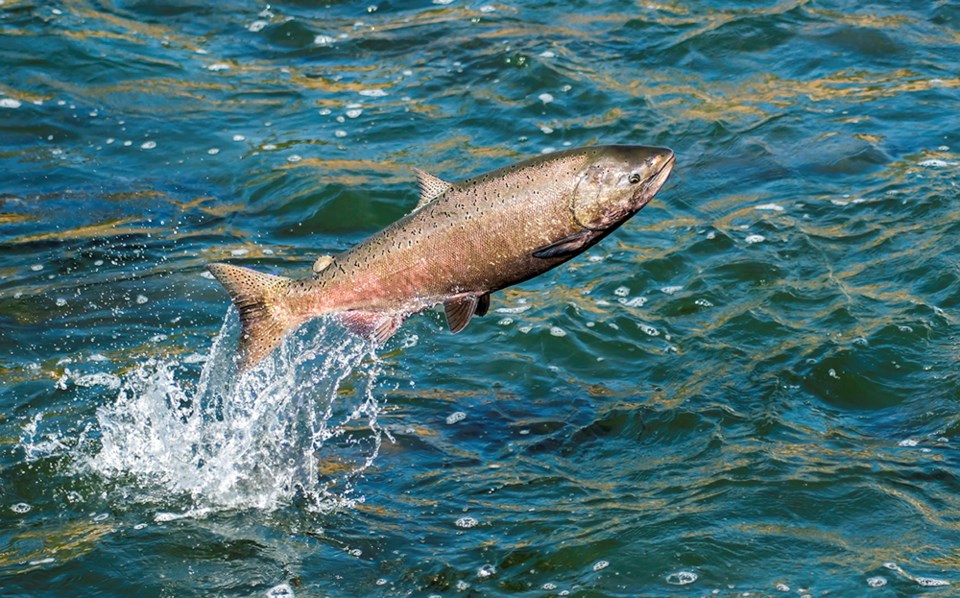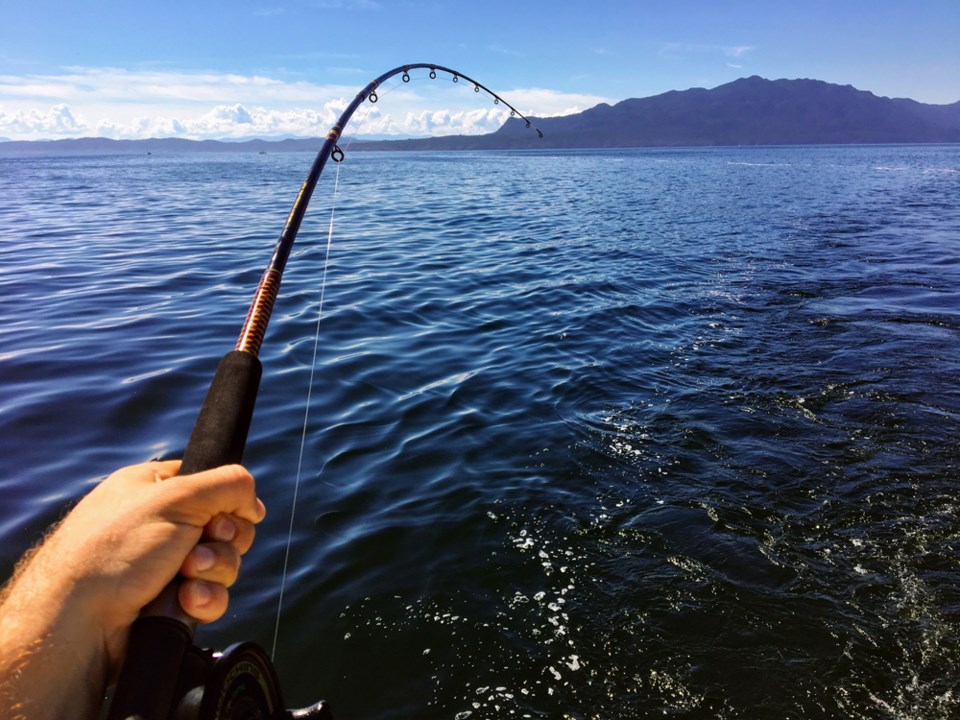Sea to Sky recreational anglers say now is the time to adjust government regulations that restrict the harvesting of chinook salmon on the south coast, including in Howe Sound, so that sport fishers can be out on the water catching a limited number of chinook for next spring and summer.
In 2019, Fisheries and Oceans Canada (DFO) imposed a closure of the chinook fishery on the south coast for most of the season, though catch-and-release was allowed.
In 2020, the closure lasted longer, until Sept. 1, and catch-and-release was banned.
Local fishers don't want the restrictions repeated next season, but fear it will be the same, or worse so they are calling for action now.
They argue the interception rate in Howe Sound waters for the stocks of concern — chinook that are endangered — is extremely low, about .5%, according to the Public Fishery Alliance.
Jason Assonitis, who has been a fishing guide in local waters for more than 30 years and angler Dave Brown, vice-chair of the Squamish to Lillooet Sport Fish Advisory Committee have met with Parliamentary Secretary to the Minister of Fisheries and Oceans MP Terry Beech and MP Patrick Weiler to demand action and answers.
While both men say they were grateful the leaders met with them, and seemed to hear their concerns, they say tangible commitments are needed, sooner rather than later.
Both want DFO to implement recommendations put forward by the Sport Fishery Advisory Board.
They say this is the matter of the utmost urgency as increasing restrictions over time are threatening the very existence of the public fishery, which has social and economic benefits.
The board, they argue, has submitted plans for a sustainable, selective limited harvest of abundant chinook stocks.
That board has been an advisory body to the Minister of Fisheries, Oceans and Canadian Coast Guard Canada on public fishery issues since 1964, and it used to be that its recommendations were taken into account in drawing up regulations, but not in recent years, they say.
In addition to limited chinook retention in local waters, the advisory board proposal also calls for the "mass marking" — clipping the adipose fin to make the fish identifiable — of 100% of hatchery chinook.
For the most part only, 10% are currently marked in Canada — though 100% of coho are marked.
In Washington State, 100% of chinook are marked.
"The longer we push this down the line, the further out we are from actually achieving it," said Brown.
"If we don't start clipping next spring, when they are doing the releases of all the chinook that are released in B.C., we are another year down the road."
It takes two to three years after a fish is clipped for it to be large enough to keep.
The benefit of having more or all of the hatchery fish identifiable is that it could create sport fishing opportunities and be positive for other sectors, Brown said.
"It could also create opportunities if the government transitions fisheries that use gillnets to methods that are more selective, such as fish traps, when the fish come through they can be taken out of the trap and they can identify a hatchery fish and say this is a fish that can be harvested."
What frustrates both men is that the DFO brass tells them the regulations restricting their fishing are about conservation yet, while the southern Georgia Strait was closed to any kind of chinook fishing — catch and release or retention — there were over 24,000 chinook netted in the Fraser River between April through September, according to DFO data, when recreationists were not allowed to fish for chinook at all.
"It is questionable that this is simply a conservation issue," Assonitis said.
Assonitis said there is no clarity on the science and data from anyone he talks to within the DFO from MPs, to deputy ministers or senior members in the department.
"What they are saying in their policy, does not line up with the management actions that are being taken."
What government officials say
Beech, the Parliamentary Secretary to the Minister of Fisheries, Oceans, did not respond to The Chief's requests for comment on this issue.
MP Weiler, however, told The Chief in an interview Friday that he heard the concerns and understands. He has taken their concerns to the Minister of Fisheries, he said.
"I absolutely feel for the challenges that they are going through right now. Particularly, you layer on not having access to fishing chinook in Howe Sound on top of the impacts to tourism that we are having right now — it is really a double-whammy that they are facing," he said.
He repeated what he and other government leaders have said before, which is that the Fraser River chinook stocks of concern have to be protected.
"The measures that were taken this year are very difficult, but they are necessary so that we can maintain those stocks, and we aren't running the risk of an extinction-level event for some of them."
He said the plans for next year are being put together now, though it will be several months before they are released.
"There is going to need to be conservation-based fisheries management measures for next year, given the status of the stocks," he said, adding that he will ensure local fishers are plugged into the process and heard.
"We all want the measures that are developed to work for everybody, and I think everybody agrees the foremost concern has to be the long-term sustainability of the stocks."
When asked then about the large number of Fraser River fish taken by gillnet fishing in comparison, he said the DFO doesn't entirely have control over that.
"First Nations have an Aboriginal right for fishing. That is constitutionally protected and it is not possible to provide a moratorium for gillnet fisheries as a result of that. They have constitutionally protected rights for food, social and ceremonial purposes, particularly on the Fraser River and that is something we cannot deviate from," he said.
He said that the input from the Sport Fishery Advisory Board is taken into consideration and did lead to some areas being opened on a pilot project this past season.
"This year, extra measures were brought in for gillnetting as well. So gillnet fishing is restricted as well so it can only operate in daylight hours and they have to be attended by a harvester at all times, so those are new measures," he said. "That is really important so that if there is anything that is caught that shouldn't be or that is incidentally caught, that can be quickly released so then you reduce the potential for mortality for fish that shouldn't be caught."
Brown said the local anglers fully support First Nations having access to the chinnok.
"We just want a science-based approach and you are saying it is a conservation and you are having a large among of chinook harvested when other sectors close completely, not even catch-and-release," he said.
"Constitutional priority for chinook goes to conservation, then First Nations, followed by sportfishers, and then commercial, he said.*
"Commercial has priority for halibut, sockeye, chum and pink salmon."
Bigger fish to fry
The anglers are not alone in their frustration. In June, Bill Bosch, president of the BC Wildlife Federation penned an open letter to Bernadette Jordan, Minister of Fisheries, Oceans & the Canadian Coast Guard.
"Broadly, the BCWF is concerned the public fishery has been marginalized, with science taking a back seat to political agendas. Fishing is considered an essential service amid this pandemic," the letter published to the organization's website reads. "Yet DFO seems to think public fisheries are unnecessary despite the well-documented social and economic value the public fishery generates annually."

Warren Barker, with the Public Fishery Alliance, told The Chief that in terms of chinook, he would like to see the retention of one chinook per day next season and an allowance for limited catch and release.
"If we are collecting data and trying to find where these fish are exactly migrating to, then it should be open to groups like the $1.1 billion [in annual sales] where they collect data."
He said when you look at the overall economics of public fishing in B.C. the closures can lead to a collapse of the public fishery.
"Sometimes it is just a perception," he said. "When you start putting more and more closures in place, then the perception is that the province is closed and that has far reaching impacts, not to just our local area, but the rest of British Columbia. As a $1.1-billion industry [in annual revenue].... that can have far-reaching effects in terms of where people spend their fishing dollars when it comes to when you are back open for tourism. People might just decide to go to another country to spend their vacation dollars if the perception is fishing is closed here."
He added that the closures represent a negative precedent, too.
"If we have these restrictions now in place, then it opens it up for DFO and the Fisheries Minister to close other areas without proper consultation. That is a concern going forward, that the public fishery is going to get swept aside in this."
He too calls for the marking of hatchery chinook.
"There are a lot of challenges that salmon have... whether it is climate change, whether it is areas that juveniles spend [time] in the rivers, those areas are being challenged for a bunch of different reasons. We want to give wild salmon every opportunity to survive, but still have opportunities where there is an abundance of hatchery chinook in an area," he said. "The two can work together."
*Please note, this story has been corrected since it was first posted to accurately reflect the quote on constitutional priority.



